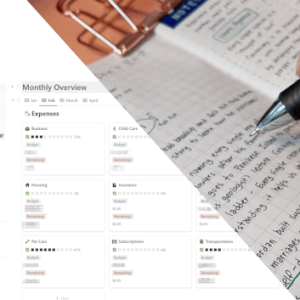Brain Dump Technique: Simple Steps to Organize Thoughts
If you’re feeling overwhelmed by a constant stream of thoughts, tasks, or ideas, the brain dump technique could be the answer you need. I started exploring the brain dump technique after feeling overwhelmed by the growing list of tasks both at work and home. It turned out to be a simple yet powerful way to clear my mind and reduce stress—and after using it for three months, I felt compelled to share what I’ve learned. This simple yet powerful method is designed to help clear mental clutter, making room for better focus, reduced stress, and improved productivity. In this guide, we’ll explore why brain dumping is beneficial, provide a step-by-step on how to do a brain dump technique effectively, and offer practical examples to help you get started.
Table of Contents
What is a Brain Dump?
A brain dump is a mental decluttering method where you jot down everything on your mind—tasks, ideas, even random thoughts—without filtering. I first came across it while searching for mindfulness tips, and the straightforward name grabbed my attention. It helps organize thoughts, reduce stress, and improve focus by offloading ideas, tasks, and concerns onto paper or a digital note. Instead of keeping everything in your head, a brain dump allows you to free up mental space, making it easier to process information and take action.
This method is commonly used for planning, problem-solving, and creative brainstorming. Whether you’re feeling overwhelmed with tasks or simply need clarity, brain dumping can be an effective way to regain control and stay organized.
Why is Brain Dumping Beneficial?
Mental clutter can create barriers to clarity and productivity, making it hard to stay organized. For me, the biggest benefit was the mental clarity that came from decluttering my thoughts. I used to feel constantly rushed because my to-do list kept growing while nothing seemed to get done. Brain dumping helped calm that internal noise—and ironically, that helped me become more productive.
🧡Mental Decluttering
The brain dump technique helps you release lingering thoughts and ideas, creating a clearer mental space. Think of it as cleaning out a messy closet: once everything is out in the open, you can see what’s essential and what’s not. Mental decluttering can even improve emotional well-being, as it reveals underlying worries or stressors that might go unnoticed otherwise.
🧡Enhanced Focus and Productivity
When you use the brain dump technique to unload all your thoughts, ideas, and worries onto paper or digital notes, you free up mental space for focused work. Without irrelevant thoughts competing for your attention, you can work more efficiently, prioritize better, and tackle tasks with renewed energy.
🧡Stress Reduction
Brain dumping offers a therapeutic release. The constant juggling of thoughts and tasks can create stress and anxiety, but this technique helps you manage and release those mental loads. If you’re feeling overwhelmed, a brain dump session can provide a sense of relief and make life’s challenges seem more manageable.
🧡Boosts Creativity
When the mind is cluttered, creativity often takes a hit. By using the brain dump technique, you make room for fresh ideas and creative solutions. Clearing out mental distractions allows you to focus on innovation and problem-solving, so you can approach projects with a clear, open mind.
🧡Supports Long-Term Planning
Brain dumps don’t just address immediate concerns—they can help with long-term planning too. Regularly jotting down thoughts and ideas creates a record of evolving goals, ambitions, and recurring themes. Revisit your brain dumps every few months to look for patterns, trends, or recurring ideas that might inspire a new direction or goal.
How to Do a Brain Dump: Step-by-Step Guide
The beauty of the brain dump technique is that it’s incredibly flexible. Here’s a step-by-step guide to make the most of your brain dump:
- Choose Your Medium
Decide whether you prefer pen and paper, a digital tool, or a mix of both. Many people feel that handwritten brain dumps provide a sense of personal connection, while digital tools like Notion or Microsoft To Do offer easy organization options. If you’re exploring To-Do list apps, you might find some helpful suggestions in my post about productivity apps. Pick a method that feels right for you, and don’t be afraid to experiment with both!
I use Microsoft To Do almost daily, especially at night when unfinished thoughts start to crowd my mind. Instead of acting on them right away, I just dump everything into the app and revisit the list in the morning. This keeps my sleep from being interrupted by racing thoughts. - Set a Timer
Keep your brain dump focused by setting a timer for 5–10 minutes. This constraint encourages you to write freely without overthinking and helps you capture as many thoughts as possible. If you’re tackling a particularly busy or stressful period, consider setting the timer for 15–20 minutes to allow for a deeper mental cleanse. - Write Freely and Without Judgment
Start by writing down every thought, task, worry, or idea that comes to mind. Don’t judge or filter yourself, as the goal is to empty your mind of everything that’s weighing on you. Even seemingly trivial ideas can hold value, so write down anything that’s lingering in your mind. - Categorize and Prioritize
Once you’re done writing, review your list and identify themes. Separate items into categories like “personal,” “work,” or “future ideas,” and highlight or circle any high-priority items. Over time, you may even develop personalized categories based on what commonly appears in your brain dumps, such as “projects,” “reminders,” and “random thoughts.” - Reflect on Your Brain Dump
Spend a few minutes reflecting on what you’ve written. Does anything surprise you? Are there thoughts or patterns you hadn’t noticed before? Reflection on your brain dump can provide valuable insight into your priorities, fears, and recurring concerns.
Brain Dump Examples for Everyday Life
A brain dump can be adapted to different areas of life, from personal tasks to professional goals. Here are some examples of what a brain dump might look like in different contexts:
- Work Tasks
- Finish quarterly report by Friday
- Schedule team meeting for next week
- Brainstorm ideas for upcoming project
- Reply to unread emails
- Update performance report metrics for review
- Personal Goals and Errands
- Grocery shopping: milk, vegetables, pasta
- Schedule a dentist appointment
- Plan next weekend’s family outing
- Research yoga or fitness classes nearby
- Clean out the garage on Saturday
- Miscellaneous Thoughts
- New book recommendations to explore
- Home organization project ideas
- Birthday gift ideas for family and friends
- Next TV series to start watching
- Volunteer opportunities to look into
These examples illustrate how versatile the brain dump technique is, as it covers everything from high-priority work tasks to random thoughts and ideas. You can use brain dumping for a weekly to-do list, long-term planning, or simply clearing your head.

When to Use Brain Dumping
While brain dumping is beneficial anytime, certain moments make this technique especially valuable:
- Weekly Planning
Start each week with a brain dump to clear your mind, set goals, and prioritize. This helps ensure you start your week with clarity and confidence. - Before Bed
If you struggle with racing thoughts before sleep, try brain dumping in the evening. It can improve your sleep quality by releasing lingering thoughts and preparing your mind for rest. - During Times of Stress or Overwhelm
When you’re stressed or overwhelmed, a quick brain dump can provide instant relief and clarity. With everything on paper, even the most overwhelming thoughts or tasks often become more manageable.
FAQ: Brain Dumping for Clarity and Focus
How to brain dump for anxiety?
Brain dumping can help relieve anxiety by offloading racing thoughts onto paper or a digital note. When I felt anxious at work, I’d step away and write down everything on my mind for five minutes—no structure, just raw thoughts. That short pause made a huge difference in helping me regain focus and feel more grounded.
How long does it take to brain dump?
A brain dump can take as little as 5 minutes or as long as 30 minutes, depending on how much you need to unload. A short, daily brain dump helps clear your mind quickly, while a longer session may be useful for planning or tackling larger projects.
How often should you do a brain dump?
The frequency depends on your needs, but many people benefit from doing a brain dump daily or weekly. A morning brain dump can help with productivity and focus, while an evening brain dump is great for winding down and reducing stress.
What is a brain dump before bedtime?
A brain dump before bed helps improve sleep by offloading lingering thoughts, tasks, or worries from your mind. Writing down unfinished tasks or concerns prevents overthinking, making it easier to relax and fall asleep. Many people use this as part of a nighttime routine to clear mental clutter before resting.
Incorporating Brain Dumping into Your Routine
After doing nightly brain dumps for a few weeks, it became part of my wind-down routine. Some days I use it for planning, others just to vent, but the regular habit has helped me sleep better and start the next day with less mental clutter.
Try incorporating a brief session into your morning or evening routine, or use it spontaneously whenever you feel overwhelmed. Some people make it a part of their weekly planning, while others find that a nightly brain dump helps them sleep better. Consistency with brain dumping can transform it into a powerful tool for maintaining mental clarity and focus.
💆♀️ Must-Try Mental Health & Mindfulness Practices
- How to Reduce Social Media Time and Regain Control of Your Life
- Pomodoro Timer: Techniques to Boost Productivity
- Brain Dump Technique: Simple Steps to Organize Thoughts
- Benefits of Decluttering: How a Tidy Space Can Transform Your Life
🌿 Explore More Mental Health & Mindfulness Tips
Looking for ways to reduce stress and improve mental clarity? Explore my mindfulness exercises, journaling techniques, and self-care habits to cultivate a balanced and peaceful mind.
🧹Must-Try Decluttering & Organization Hacks
- Skincare Decluttering: What Stayed and What Had to Go
- Knitting Supplies Storage: Compact Container for Crochet Tools
- My Favorite To-Do List App—and How to Make the Most of It
- Craft Organization Ideas: Simple Storage Solutions for Supplies
- How to Declutter Your Space: 6 Easy and Simple Decluttering Tips
🧹More Ways to Organize, Simplify, and Declutter
Looking to create a clutter-free, organized, and intentional lifestyle? Explore my minimalism, organization tips, and decluttering hacks to streamline your space, boost efficiency, and focus on what truly matters.
📝 Must-Try Journaling Ideas & Inspiration
- Stamping Essentials: My Must-Have Tools for Better Results
- System Techo vs. Bullet Journal: My 2025 Productivity Planner
- My 2025 Journal lineup: System Techo & Midori Daily Journal
- Analog vs. Digital Journaling: Which One Suits Your Needs?
- Analog Journaling 101: Types, Benefits & Best Tips
📖 Explore More Journaling Tips & Techniques
Looking for new ways to enhance your journaling practice? Discover my journaling tips, creative prompts, and organization ideas to make the most of every page!




















